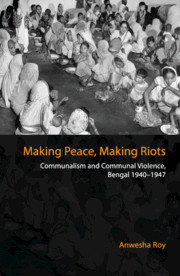Book contents
- Frontmatter
- Frontmatter
- Contents
- Maps and Figures
- Acknowledgements
- Abbreviations
- Glossary
- Introduction
- 1 The Dacca Riot, 1941
- 2 Famine 1943 – Towards a Hardening of Community Identities
- 3 From Community to Communal: The Bengal Secondary Education Bill and the Idea of Pakistan
- 4 The Great Calcutta Killing, August 1946
- 5 Noakhali Riots, October 1946
- 6 A Test of Faith: Gandhi in Noakhali and Calcutta 1946–47
- Concluding Remarks
- Appendix 1
- Appendix 2
- Appendix 3
- Appendix 4
- Bibliography
- Index
5 - Noakhali Riots, October 1946
Published online by Cambridge University Press: 23 October 2018
- Frontmatter
- Frontmatter
- Contents
- Maps and Figures
- Acknowledgements
- Abbreviations
- Glossary
- Introduction
- 1 The Dacca Riot, 1941
- 2 Famine 1943 – Towards a Hardening of Community Identities
- 3 From Community to Communal: The Bengal Secondary Education Bill and the Idea of Pakistan
- 4 The Great Calcutta Killing, August 1946
- 5 Noakhali Riots, October 1946
- 6 A Test of Faith: Gandhi in Noakhali and Calcutta 1946–47
- Concluding Remarks
- Appendix 1
- Appendix 2
- Appendix 3
- Appendix 4
- Bibliography
- Index
Summary
The next place where the communal drama unfolded was at Noakhali and Tippera districts in East Bengal. More prolonged than the Calcutta riots, they started on 10 October 1946 and continued in a sporadic form till December 1946. In several ways, they seemed like a spill-over from the Calcutta Killings, a vengeance for the killing of thousands of Muslims in Calcutta. Nirmal Kumar Bose points out that although the ‘battle of Calcutta’ might not have proved decisive, ‘enthusiastic followers of the two-nation theory felt that the war had to be carried on further and a decisive victory gained at some other advantageous point in Bengal.’ However, a deeper look would reveal that it was not just a simple reaction. We have seen in the third chapter how the peasant-moneylender-zamindar conflict in East Bengal aided the growth of community-based consciousness and made Pakistan a dominant issue. We have studied the complex socio-economic and political factors and their impact when they were combined with communal nationalism in the 1940s.
Noakhali was no different. The causes of the riot were tied to these deeper and longer roots. The famine of 1943 had led to massive devastation in Noakhali. It was one of the main areas where the Denial Policy was in operation, turning it into one of the most rice deficit districts in the province. About 75,000 people had been evacuated from Noakhali and 20,000 from Tippera after the Japanese victories at Singapore and Malaya. Noakhali and Tippera were also jute growing districts. During the War, the price of the crop had plunged drastically. With the rise in the price of foodstuff, the gap between revenue from agricultural products and the expenditure on food stuffs, increased. This further wrecked the peasant household economy in these two districts. The economic crisis continued till the end of 1946. Even in September 1946, the price of rice remained high, selling at Rs 28 per maund in Noakhali and Rs 30 per maund in some parts of Tippera. By October, prices had risen above Rs 30. As Sugata Bose remarks, ‘This was considerably higher than the provincial average of Rs 17 annas 11 on 9 October at the principal district marketing centres’.
- Type
- Chapter
- Information
- Making Peace, Making RiotsCommunalism and Communal Violence, Bengal 1940–1947, pp. 184 - 213Publisher: Cambridge University PressPrint publication year: 2018



